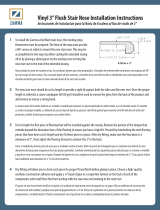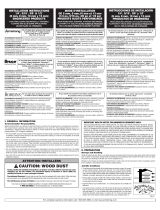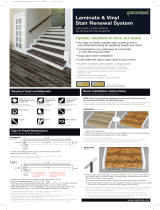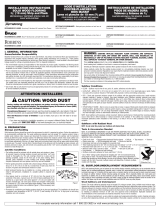
0180_Jan20_StairNose P.1
Stair Nose Molding for Flooring
Prior to beginning the installation, any loose or damaged treads or risers should be
repaired or replaced. The stairs must be cleaned thoroughly from any loose paint,
debris, or old adhesives.
Begin by calculating your plank’s total height. Note: if you are installing on a stair tread,
and loose lay underlayment was not included for the stair application, do not include
the underlayment thickness in the total height. Do include the underlayment height for
all other applications. Consult the table below to determine if a shim will be necessary
for your application. Shims are included in each stair nose molding package.
Stair Nose Molding | English

0180_Jan20_StairNose P.2
Step down from a oating oor
Cut the stair nosing to the desired length. Depending on the suboor material, follow
the appropriate instruction for adhering the stair nosing per detailed instructions
below. A ¼” expansion space must be maintained between the nosing and the
oating oor. If a shim is necessary for your application, adhere the shim to the nosing
with construction adhesive and adhere the shim and nosing to the suboor with
construction adhesive and fasten with screws.
Fastening to Wood Suboors
Use a premium grade of construction adhesive and trim screws at least 11⁄8” in length.
Drill holes in the molding for the fasteners. Countersink the screws and ll with nishing
putty. When fastening the stair nosing, space screws 2” from each baseboard or
stringer and a maximum distance of 8” apart down the length of the nosing.
Fastening to Concrete Suboors
Drill into the concrete suboor with a carbide drill bit. Insert an appropriate anchor into
the concrete to accommodate the fastener then follow the procedure above.
Stair Nosings on Stair Treads
Due to the many varieties of stairs available, a professional stair contractor may be
required for certain installations. Check local building codes before altering dimensions
of stair tread, riser and nosing.
Stair Nose Molding | English

0180_Jan20_StairNose P.3
IMPORTANT HEALTH NOTICE FOR MINNESOTA RESIDENTS ONLY: THESE BUILDING MATERIALS
EMIT FORMALDEHYDE. EYE, NOSE, AND THROAT IRRITATION, HEADACHE, NAUSEA AND A VARIETY
OF ASTHMA-LIKE SYMPTOMS, INCLUDING SHORTNESS OF BREATH, HAVE BEEN REPORTED AS A
RESULT OF FORMALDEHYDE EXPOSURE. ELDERLY PERSONS AND YOUNG CHILDREN, AS WELL AS
ANYONE WITH A HISTORY OF ASTHMA, ALLERGIES, OR LUNG PROBLEMS, MAY BE AT GREATER
RISK. RESEARCH IS CONTINUING ON THE POSSIBLE LONG-TERM EFFECTS OF EXPOSURE
TO FORMALDEHYDE. REDUCED VENTILATION MAY ALLOW FORMALDEHYDE AND OTHER
CONTAMINANTS TO ACCUMULATE IN THE INDOOR AIR. HIGH INDOOR TEMPERATURES AND
HUMIDITY RAISE FORMALDEHYDE LEVELS. WHEN A HOME IS TO BE LOCATED IN AREAS SUBJECT TO
EXTREME SUMMER TEMPERATURES, AN AIR-CONDITIONING SYSTEM CAN BE USED TO CONTROL
INDOOR TEMPERATURE LEVELS. OTHER MEANS OF CONTROLLED MECHANICAL VENTILATION CAN
BE USED TO REDUCE LEVELS OF FORMALDEHYDE AND OTHER INDOOR AIR CONTAMINANTS. IF YOU
HAVE ANY QUESTIONS REGARDING THE HEALTH EFFECTS OF FORMALDEHYDE, CONSULT YOUR
DOCTOR OR CALL LOCAL HEALTH DEPARTMENT.
WARNING: Drilling, sawing, sanding or machining wood products can expose you to wood dust, a
substance known to the state of California to cause cancer. Avoid inhaling wood dust or use a dust mask or
other safeguards for personal protection. For more information, go to www.P65Warnings.ca.gov/wood.
Stair Nose Molding | English

0180_Jan20_StairNose P.4
Nez de Marche pour Plancher
Avant de commencer l’installation, vous devez réparer ou remplacer tous les girons
ou les contremarches mal xés ou endommagés. L’escalier doit être bien nettoyé pour
enlever la peinture décollée, les débris ou les vieilles colles.
Commencez par calculer la hauteur totale de la planche. Remarque : si vous installez
la pièce sur un giron, et qu’il n’y a pas de souscouche d’incluse pour les escaliers, ne
calculez pas l’épaisseur de la sous-couche dans la hauteur totale. Calculez l’épaisseur
de la sous-couche pour toutes les autres applications. Consultez le tableau ci-dessous
pour déterminer si vous avez besoin d’une cale pour votre installation. Les cales sont
comprises dans chaque emballage de nez de marche.
Stair Nose Molding | Français

0180_Jan20_StairNose P.5
Pas de marche supérieure qui mène à l’escalier
Coupez le nez de marche à la longeur désirée. Selon le matériel du sous-plancher,
veuillez suivre les instructions appropriées pour coller le nez de marche parmi celles
détaillées ci-dessous. Un espace d’expansion de ¼ po doit être laissé entre le nez et le
plancher ottant. Si vous devez utiliser une cale pour votre installation, collez-la au nez
de marche avec de la colle de construction et collez l’ensemble au sous-plancher avec
de la colle de construction en xant le tout avec des vis.
Installation sur un sous-plancher en bois
Utilisez une colle de construction de bonne qualité et des vis d’au moins 11⁄8
po de longeur. Percez des trous dans le nez pour y insérer les vis. Vissez les vis
profondément et remplissez les trous avec la pâte de nition. Au moment de xer
solidement le nez de marche, espacez les vis à 2 po de chaque planche de base ou
d’un limon et à une distance maximum de 8 po l’une de l’autre le long du nez.
Installation sur un sous-plancher en béton
Percez le sous-plancher en béton avec une mèche au carbure. Insérez le bouchon
approprié dans le béton pour y insérer une vis puis suivez la procédure ci-dessous.
Nez de marche sur les girons
En raison des nombreux modèles d’escaliers diérents oerts sur le marché, il est
possible que vous deviez avoir recours à un entrepreneur spécialisé dans les escaliers
pour certaines installations. Veuillez consulter les codes de construction avant de
modier le giron, la contremarche et le nez.
Stair Nose Molding | Français

0180_Jan20_StairNose P.6
AVIS DE SANTÉ IMPORTANT À L’ATTENTION DES RÉSIDENTS DU MINNESOTA :CERTAINS DES
MATÉRIAUX UTILISÉS POUR LA CONSTRUCTION DE CETTE DEMEURE (OUCES MATÉRIAUX DE
CONSTRUCTION) ÉMETTENT DU FORMALDÉHYDE. DES IRRITATIONS AUX YEUX, AU NEZ ET À LA
GORGE, DES MAUX DE TÊTE, DES NAUSÉES ET DIFFÉRENTS SYMPTÔMES SEMBLABLES À CEUX
DE L’ASTHME, COMME L’ESSOUFFLEMENT, ONT ÉTÉ RAPPORTÉS À LA SUITE D’UNE EXPOSITION
AU FORMALDÉHYDE. LES PERSONNES ÂGÉES ET LES JEUNES ENFANTS, DE MÊME QUE TOUTE
PERSONNE AVEC DES ANTÉCÉDENTS D’ASTHME, D’ALLERGIES OU DE PROBLÈMES PULMONAIRES,
PEUVENT ÊTRE PLUS VULNÉRABLES. LES RECHERCHES SE POURSUIVENT SUR LES EFFETS
POTENTIELS À LONG TERME D’UNE EXPOSITION AU FORMALDÉHYDE.UNE VENTILATION RÉDUITE
PEUT PERMETTRE AU FORMALDÉHYDE ET À D’AUTRES CONTAMINANTS DE S’ACCUMULER
DANS L’AIR INTÉRIEUR. LES TEMPÉRATURES ÉLEVÉES À L’INTÉRIEUR AUGMENTENT LES NIVEAUX
DE FORMALDÉHYDE. LORSQU’UNE MAISON EST SITUÉE DANS UNE RÉGION SUJETTE À DES
TEMPÉRATURES ESTIVALES EXTRÊMES, LES NIVEAUX DE TEMPÉRATURE INTÉRIEURE PEUVENT
ÊTRE CONTRÔLÉS À L’AIDE D’UN SYSTÈME DE CLIMATISATION. D’AUTRES MÉTHODES DE
VENTILATION MÉCANIQUE CONTRÔLÉE PEUVENT ÊTRE UTILISÉES POUR RÉDUIRE LES NIVEAUX DE
FORMALDÉHYDE ET D’AUTRES CONTAMINANTS DE L’AIR INTÉRIEUR.SI VOUS AVEZ DES QUESTIONS
À PROPOS DES EFFETS DU FORMALDÉHYDE SUR LA SANTÉ, CONSULTEZ VOTRE MÉDECIN OU LES
SERVICES DE SANTÉ LOCAUX.
Avertissement : Le perçage, le sciage, le ponçage et l’usinage des produits en bois peuvent vous exposer à
la poussière de bois, une substance reconnue par l’État de la Californie comme étant la cause de cancers.
Évitez d’inhaler la poussière de bois ou utilisez un appareil respiratoire ou d’autres mesures de sécurité pour
vous protéger. Pour plus d’informations, allez à www. P65Warnings.ca.gov/wood.
Stair Nose Molding | Français

0180_Jan20_StairNose P.7
Moldura de Escalón para Pisos
Antes de comenzar la instalación, se debe reparar o reemplazar todo peldaño o apoyo
dañado o ojo. Las escaleras deben limpiarse bien y no tener pintura suelta, desechos
o viejos adhesivos.
Para comenzar, calcule la altura total del tablón. Nota: si está efectuando la instalación
en un peldaño y no se incluyó el bajopiso sin pegamento para la escalera, no incluya
el espesor del bajopiso en la altura total. Sí incluya la altura del bajopiso en todas las
demás aplicaciónes. Consulte la tabla a continuación para determinar si necesitará
un espaciador. Todas las cajas de molduras para el borde de los escalones incluyen
espaciadores
Stair Nose Molding | Español

0180_Jan20_StairNose P.8
Terminación descendente desde un piso otante
Corte el borde del escalón del largo deseado. Siga las detalladas instrucciones
correspondientes al material del subsuelo que se indican a continuación para adherir
el borde del escalón. Se debe mantener un espacio de expansión de 6,3 mm (¼”) entre
el borde del escalón y el piso otante. Si necesita un espaciador para su aplicación,
adhiera el espaciador al borde del escalón con adhesivo para construcción y adhiera el
espaciador y el borde del escalón al subsuelo con adhesivo para construcción y fíjelo
con tornillos.
Sujeción a subsuelos de madera
Use un adhesivo para construcción de primera calidad y tornillos de moldura de
11⁄8” de largo como mínimo. Taladre los oricios en la moldura para los sujetadores.
Inserte los tornillos y rellene con masilla para terminación. Para sujetar los bordes de
las escalera, separe los tornillos a 5,08 cm (2”) de cada zócalo o travesaño y a una
distancia máxima de 20,3 cm (8”) entre sí a lo largo del borde.
Sujeción a subsuelos de cemento
Taladre en el subsuelo de cemento con una broca de carburo. Introduzca una
clavija adecuada en el cemento para colocar el sujetador y siga el procedimiento a
continuación.
Rebordes de escalón en peldaños de escalera
Debido a la amplia variedad des escaleras disponibles, en algunas instalaciones puede
ser necesario utilizar los servicios de un contratista profesional de escaleras. Consulte
los códigos de edicación locales antes de modicar las dimensiones de los peldaños
de escalera, apoyos y bordes de la escalera.
Stair Nose Molding | Español

0180_Jan20_StairNose P.9
AVISO DE SALUD IMPORTANTE, SÓLO PARA RESIDENTES DE MINNESOTA: ESTOS MATERIALES DE
CONSTRUCCIÓN EMITEN FORMALDEHIDOS. SE HA INFORMADO DE LA PRESENCIA DE IRRITACIÓN
EN LOS OJOS, LA NARIZ Y LA GARGANTA, DOLORES DE CABEZA, NÁUSEAS Y VARIOS SÍNTOMAS
PARECIDOS AL ASMA, LO QUE INCLUYE DIFICULTADES PARA RESPIRAR, COMO RESULTADO DE LA
EXPOSICIÓN A LOS FORMALDEHIDOS. LAS PERSONAS MAYORES Y LOS NIÑOS PEQUEÑOS, ADEMÁS
DE CUALQUIER PERSONA CON ANTECEDENTES DE ASMA, ALERGIAS O PROBLEMAS PULMONARES,
PUEDEN CORRER UN MAYOR RIESGO. ACTUALMENTE SE INVESTIGAN LOS POSIBLES EFECTOS A
LARGO PLAZO DE LA EXPOSICIÓN A LOS FORMALDEHIDOS. UNA VENTILACIÓN DEFICIENTE PUEDE
PROVOCAR QUE LOS FORMALDEHIDOS Y OTROS CONTAMINANTES SE ACUMULEN EN EL AIRE DEL
INTERIOR. LAS TEMPERATURAS INTERIORES ALTAS Y LA HUMEDAD AUMENTAN LOS NIVELES DE
FORMALDEHIDOS. EN EL CASO DE LAS CASAS UBICADAS EN ÁREAS SUJETAS A TEMPERATURAS
VERANIEGAS EXTREMAS, SE PUEDE USAR UN SISTEMA DE AIRE ACONDICIONADO PARA CONTROLAR
EL NIVEL DE LA TEMPERATURA DEL INTERIOR. SE PUEDEN USAR OTROS MÉTODOS DE VENTILACIÓN
MECÁNICA CONTROLADA PARA DISMINUIR LOS NIVELES DE FORMALDEHIDOS Y OTROS
CONTAMINANTES DEL AIRE DEL INTERIOR. SI TIENE ALGUNA PREGUNTA ACERCA DE LOS EFECTOS
EN LA SALUD DE LOS FORMALDEHIDOS, CONSULTE A SU MÉDICO O LLAME AL DEPARTAMENTO
LOCAL DE SALUD.
ADVERTENCIA: Los productos para taladrar, aserrar, lijar o cortar madera pueden exponerlo al polvo de
madera, una sustancia reconocida por el estado de California como causante de cáncer. Evite inhalar el
polvo de la madera o utilice una mascarilla antipolvo u otros artículos de protección personal. Para obtener
más información, visite www.P65Warnings.ca.gov/wood.
Stair Nose Molding | Español
-
 1
1
-
 2
2
-
 3
3
-
 4
4
-
 5
5
-
 6
6
-
 7
7
-
 8
8
-
 9
9
Pergo MG001907 Guía de instalación
- Tipo
- Guía de instalación
En otros idiomas
- français: Pergo MG001907 Guide d'installation
- English: Pergo MG001907 Installation guide
Documentos relacionados
Otros documentos
-
Home Decorators Collection HC05 Guía de instalación
-
Home Decorators Collection HC05 Guía de instalación
-
 Zamma 0157845653688 Guía de instalación
Zamma 0157845653688 Guía de instalación
-
Armstrong Flooring A6541MX1 Guía de instalación
-
Zamma 016143948 Especificación
-
 Bruce EVS3231EE Guía de instalación
Bruce EVS3231EE Guía de instalación
-
 Bruce EHWR54L50W Guía de instalación
Bruce EHWR54L50W Guía de instalación
-
Zamma 016071885 Guía de instalación
-
 Cap A Tread 016044572 Guía de instalación
Cap A Tread 016044572 Guía de instalación
-
 Bruce ABC426 Guía de instalación
Bruce ABC426 Guía de instalación













